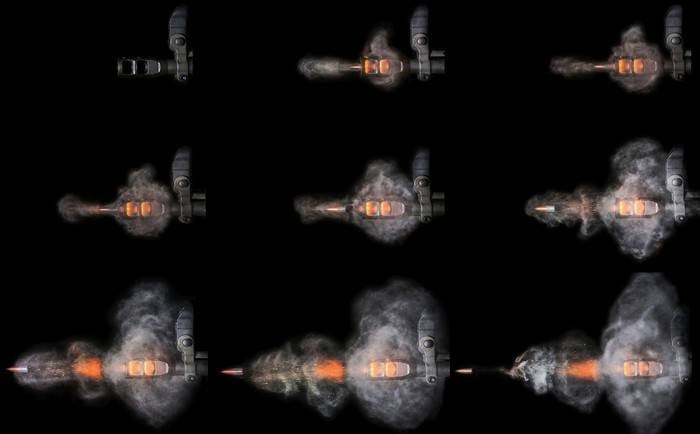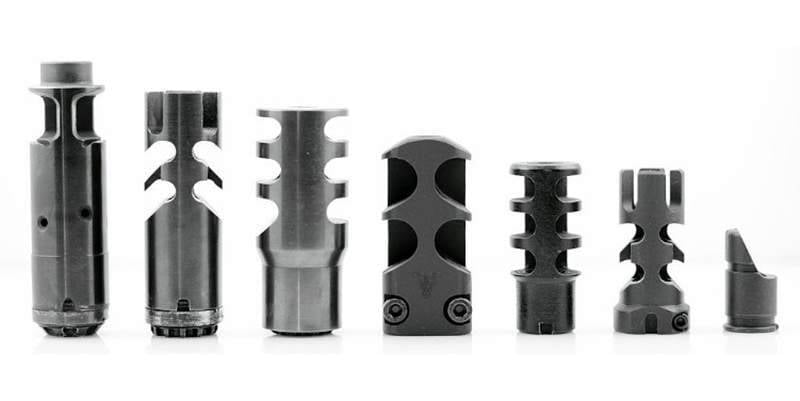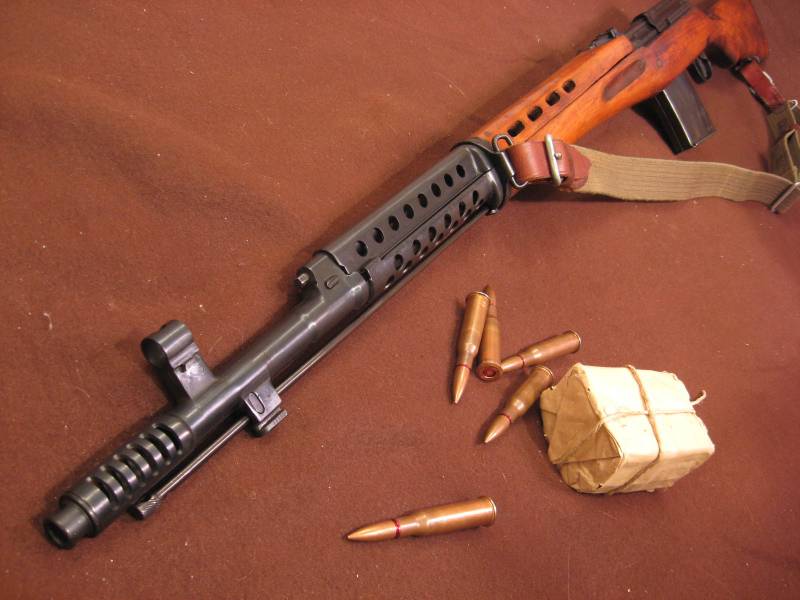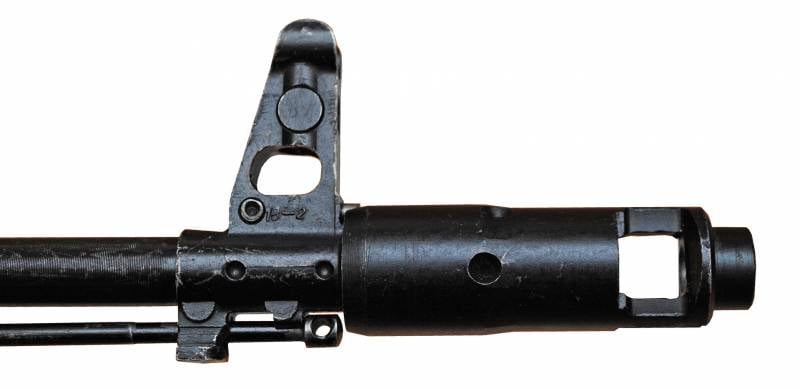Muzzle brake compensator and its purpose
The muzzle brake was known before the beginning of the Second World War, but it was during the war years and after its completion that this device became the most widespread. Initially, DTCs were used in artillery, but with the development and widespread use of automatic small arms, they were also used on small caliber weapons. Today practically all modern machine guns and machine guns are equipped with a muzzle brake-compensator by default. DTC redirects the powder gases and really reduces the recoil and toss of the barrel when firing. They are in demand not only in models of military weapons, but also in civilian models used by arrows-athletes. At the same time, by changing the direction of movement of the powder gases, the DTC can amplify the sound of a shot heard by the gunner or artillery crew. In this case, the more efficient the device, the louder the sound of the shot. For athletes, this is not a particular problem, they usually use headphones, but in military units, individual hearing protection is more a luxury. Therefore, very often, designers of army small arms intentionally limit the effectiveness of the DTC.
Existing today muzzle brakes use the energy of a certain part of the powder gases that leave the barrel after the fired bullet. Muzzle gas devices are more beneficial in terms of energy, they do not degrade the ballistics of weapons, in addition, they are characterized by high reliability and simplicity of the device. The effectiveness of the use of such devices significantly depends on the speed, quantity and direction of movement of the powder gases drawn back. At the same time, an increase in the efficiency of their work is usually accompanied by a strong action of powder gases on the shooter or the installation, making it difficult for the aiming process, as well as on the ground, which provokes unmasking due to the formation of dust that rises from the powder gases. Through the use of various muzzle gas devices, designers can significantly reduce the energy of recoil of small arms or moving parts of its automation, reduce the fieryness of the shot, increase the accuracy of firing from automatic weapons, etc.

All muzzle brakes by their nature of the impact on the weapon can be divided into three main groups:
- muzzle brakes of axial action, they provide a reduction in the recoil energy of the weapon or barrel only in the longitudinal direction;
- muzzle brakes of transverse action, they provide the effect of transverse force directed perpendicular to the axis of the bore. Such muzzle brakes are often also called compensators, they are usually used in samples of handguns in which an overturning moment may occur that deflects the axis of the barrel in the lateral direction;
- The muzzle brakes of the combined action, they provide both a reduction in the recoil force in the longitudinal direction, and the creation of lateral force, which compensates for the overturning moment of the firearm. Such muzzle brakes are called brake-compensators. They are used primarily in modern models of small arms.

By their principle of action, muzzle brakes are divided into models of active action, reactive action, and active-reactive action.
Muzzle brakes active action used in the strike of the gas jet coming out of the barrel on the surface, which is fixed on the barrel of the weapon. Such a blow generates an impulse of force directed against the action of recoil of a weapon, thereby ensuring a reduction in the recoil energy of the entire system.
In automatic models of small arms the most widespread are muzzle brakes of the reactive type, the action of which is based on the use of the reaction of the expiration of powder gases. Their main purpose is to reduce the recoil energy of the barrel or the entire weapon system by providing a symmetric removal of a part of the powder gases in the direction of recoil. At the time of the bullet's departure from the bore, a portion of the powder gases is retracted through special channels in the muzzle brake. Simultaneously, under the action of the reaction of the expiration of powder gases, all weapons receive a push forward, the recoil energy decreases. The greater the volume of gases will be retracted and the higher their speed of movement, the more effectively the muzzle brake will work.
In models of muzzle brakes of active-reactive type, both of the above principles are combined with each other. In such devices, the gas jet is struck in the forward direction (active action) and the jet is thrown backward (reactive action). A similar device was used, for example, on the Tokarev SVT-40 self-loading rifle of the 1940 model of the year.
Also muzzle brakes can be classified according to design features, which can significantly affect the efficiency of these devices. The main such design features include: the presence or vice versa of the absence of a diaphragm (front wall); the number of rows of side holes; number of cameras; shape of the side holes. The muzzle brake, which has no diaphragm and front wall, is called tubeless. At the same time, a muzzle brake equipped with a diaphragm provides greater efficiency in comparison with tubeless devices by creating an additional pulling force in the opposite direction to recoil, this is ensured by the impact of the expiring powder gas on the diaphragm. In modern weapons, one-camera and two-chamber models of muzzle brakes are most common, as a further increase in the number of cameras only slightly increases the efficiency of such devices (no more than 10 percent), while the weight and dimensions increase. The shape of the side holes can be different: rectangular or square windows, longitudinal or transverse slots, round holes. In these cases, muzzle brakes are called respectively - single, slotted or net. Within each of the chambers such openings can be located in one or several rows at once, both along the perimeter and along the length of the muzzle.
Along with the muzzle brakes in modern models of automatic small arms, compensators are very widely used - devices designed for asymmetric removal of powder gases to the side of the barrel bore axis, which is necessary to stabilize the weapon during firing. Muzzle brake-compensators work due to the impact of powder gases, which expire from the barrel in the direction opposite to the action of the overturning moment. Typical models of modern DTK can stabilize weapons when shooting in one or two planes.
Today muzzle brakes are very actively and massively used in small arms. One of the reasons for their widespread use by designers is the simplicity of the device, which is combined in them with high efficiency of action. In the automatic weapons of today, muzzle brakes are equipped with large-caliber machine guns and small-caliber guns in order to reduce the recoil effect on the machine, as well as self-loading and assault rifles, machine guns, submachine guns, high-precision large-caliber rifles for powerful cartridges.
Today, the famous Kalashnikov assault rifle, AK-74, can be attributed to one of the most well-known and widespread examples of the use of the muzzle brake-compensator. This model of automatic weapons, among other changes, was distinguished by the presence of a fundamentally new design of the DTC compared to the previously used device on the AKM machine gun.
The AK-74 machine gun had a noticeably more improved muzzle brake-compensator, which became a long and two-chamber device. The first chamber of the DTC of this automaton was a cylinder that was intended to exit the bullet; it also had three outlet openings for powder gases and two slots located near the diaphragm. The second chamber of the compensator had a slightly different device - two wide windows, and in front - the same diaphragm for the bullet exit. Such design changes allowed to increase the tactical and technical characteristics of the machine. In particular, they had a positive effect on the accuracy of shooting and balancing; at the same time, the shooter’s disguise improved, as the flashes of the flame at the moment of the shot became very difficult to notice. In one form or another, such a design, as well as its modifications (DTK 1-4), are used in Kalashnikov assault rifles and in our days.
Information sources:
http://bratishka.ru/archiv/2007/8/2007_8_9.php
http://weaponland.ru/publ/vspomogatelnye_mekhanizmy_i_prisposoblenija_strelkovogo_oruzhija_chast_i/17-1-0-247
https://zbroya.info/ru/blog/10445_dtk-ili-dulnyi-tormoz-kompensator-preimushchestva-i-nedostatki/
Open source materials


Information